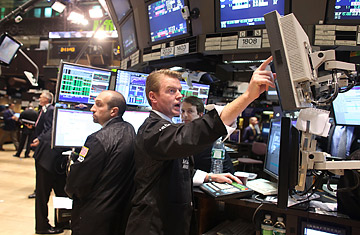
Traders work on the floor of the New York Stock Exchange
The Securities & Exchange Commission (SEC), concerned about the exponential growth of hyper-frequency trading, announced on Tuesday, Aug. 4, that it was considering a ban on one form of this activity, known as flash trading. But it has said nothing about an even bigger element of high-frequency trading, known as co-location, even as the New York Stock Exchange (NYSE) is building two new facilities to house such traders.
High-frequency trading is a catchall description of several different approaches to stock-trading that capitalize on the blinding speed of supercomputers in analyzing and responding to market data. The owners of these supercomputers, investment firms such as Goldman Sachs and Citadel Investment in Chicago, employ special proprietary algorithms to interpret the data and execute transactions — all in less time than it takes a human to conjure a thought. Already, various forms of high-frequency trading, taken together, account for more than half of all trading now taking place in the U.S. Critics say the practice can raise the cost of trading for typical investors and contributes to market volatility.
Here's how firms capitalize on one aspect of high-frequency trading known as co-location: after paying a fee to an exchange, firms are allowed to co-locate, i.e., rent server space within or near the NYSE or another exchange's computer servers to get access to trading statistics faster — just milliseconds faster — than competing investors. This is just one of the techniques that have come to light in recent weeks as the result of a paper by Sal Arnuk and Joseph Saluzza, co-founders of Themis Trading.
About 130 NYSE clients use its co-location services, according to the NYSE website, where the service is marketed as something of an advantage — "when proximity to the market can give your business model a competitive edge." That edge can translate into huge profits for high-frequency-trading firms like Goldman Sachs, which, according to Bloomberg, made more than $100 million in trading revenue on a record 46 separate days during the second quarter, or 71% of the time — partly thanks to high-frequency trading.
"All of them have the ability to execute at lightning speed, and the closer their computers are to the ultimate destinations, i.e. exchanges, the more of an advantage they have," says Arnuk, whose paper began circulating several months ago, setting Wall Street abuzz.
But Arnuk also asserts that co-location gives firms that can afford to do it an unfair advantage, because the exchange is "offering them things that the general investor does not get." (Firms pay for the server space they use: as little as $50,000 a year, but as much as $500,000 a month to co-locate at the NYSE and other exchanges, says Murray White, senior vice president of global technologies at the exchange.)
Partha Mohanram, a professor of accounting at Columbia University and an expert on financial disclosure, agrees that firms that co-locate are at a huge advantage because as exchanges are charging for the service, it can't be considered equal access, even if the service is being offered to everyone. "To say that all high-frequency trading is bad and should be banned is an overreaction, but if preferred access is being sold, that is a problem that should be addressed," he says.
While critics of co-location cry foul, reps from the NYSE say co-location is common and fair and that all exchanges charge for similar services. The exchange doesn't consider it special access because any firm that wants to can pay the fee and co-locate. Furthermore, firms that co-locate aren't at much of an advantage if they don't know how to program their computers with the algorithms that will ultimately keep them ahead of the crowd.
"Fast doesn't help if your algo isn't being optimized," White says. "In fact, we've taken great pains in our new global data centers to make sure that we've preserved fair access to all members."
One thing the exchange is not doing is telling the public just who it is that uses the exchange's special access to conduct high-frequency trades. The NYSE plans to keep secret the small group of investment firms that collectively make what could be billions of dollars a year off their special access.
And while there has always been some level of special access at the NYSE in the form of trading members who could do more than other firms, the big difference is that that list is public. The NYSE's push to keep the list of firms using co-location services private continues to keep what some consider a shady practice even more in the shadows.
And the secret list of users is sure to grow: the massive new U.S. data center, created because "co-location space has gotten pretty scarce," White says, is set to open next year in Mahwah, N.J. Another is planned to open next year in the U.K. just outside London. (Though the new facilities will be far from the NYSE headquarters on Wall Street, it's proximity to the exchange servers that matters to traders, and those servers will surely be at the new sites.)
Other observers argue that there's no way to regulate the markets so that some firms won't have some sort of advantage. "The idea that everyone would get the exact same information at the exact same time is a silly idea," says Nina Mehta, senior editor at Trader's Magazine. "(You) just can't do that."
Still, Arnuk says the problem isn't resolved so long as exchanges are making markets more opaque and multi-tiered than ever. "If small investors and if long-term investors — and by long-term investors, I mean longer than a few seconds — if long-term investors don't have confidence that they're on [a level] playing field with giant supercomputers ... How are they going to feel about owning equities? That's the real scare."
